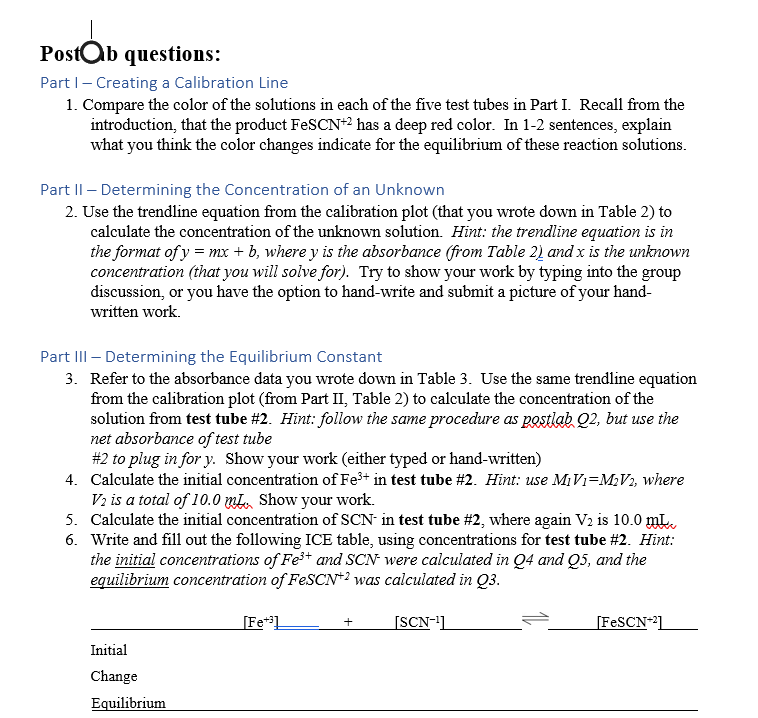2. Use the trendline equation from the calibration plot (that you wrote down in Table 2) to calculate the concentration of the unknown solution. Hint: the trendline equation is in the format of y = mx + b, where y is the absorbance (from Table 2) and x is the unknown concentration (that you will solve for). Try to show your work by typing into the group discussion, or you have the option to hand-write and submit a picture of your hand- written work.
2. Use the trendline equation from the calibration plot (that you wrote down in Table 2) to calculate the concentration of the unknown solution. Hint: the trendline equation is in the format of y = mx + b, where y is the absorbance (from Table 2) and x is the unknown concentration (that you will solve for). Try to show your work by typing into the group discussion, or you have the option to hand-write and submit a picture of your hand- written work.
Principles of Instrumental Analysis
7th Edition
ISBN:9781305577213
Author:Douglas A. Skoog, F. James Holler, Stanley R. Crouch
Publisher:Douglas A. Skoog, F. James Holler, Stanley R. Crouch
Chapter14: Applications Of Ultraviolet-visible Molecular Absorption Spectrometry
Section: Chapter Questions
Problem 14.12QAP
Related questions
Question
![Table 1: Absorbance data recorded for five 0.200 M Fe(NO:)3 solutions at 20.0 °C
Beaker
0.0020 M
[FESCN2+] (M) Abs.
0.00200
SCN (mL)
Fe(NO3)3
(mL)
5.0
0.00
0.00 M
-0.001
2
5.0
2.00
8.0 x 10-5 M
0.278
5.0
3.00
1.2 x 10-4 M
0.415
4
5.0
4.00
1.6 x 10-4 M
0.555
5.0
5.00
2.0 x 10-4 M
0.671
Part 1: y=3386x+0.0043
R^2=0.9991
Part II – Determining Concentration of an Unknown
Table 2: Best-fit line and Absorbance data of unknown solution
Best-fit line equation from Part I
Absorbance reading of unknown
0.338
Part III – Determining the Equilibrium Constant
Test tube
0.0020 M
0.00200
H20 (mL)
Abs.
Net Abs
Fe(NO3)3
(mL)
SCN-(mL)
1
3.00
0.00
7.00
0.000
2
3.00
2.00
5.00
0.119
0.119
3
3.00
3.00
4.00
0.212
0.212
4
3.00
4.00
3.00
0.265
0.265
5
3.00
5.00
2.00
0.335
0.335](/v2/_next/image?url=https%3A%2F%2Fcontent.bartleby.com%2Fqna-images%2Fquestion%2F24f86f4e-8c46-41d0-94e7-75044ed19b9e%2F9e3c58c2-27db-4970-9ebe-1947fca5ee59%2F2tjpaqj_processed.png&w=3840&q=75)
Transcribed Image Text:Table 1: Absorbance data recorded for five 0.200 M Fe(NO:)3 solutions at 20.0 °C
Beaker
0.0020 M
[FESCN2+] (M) Abs.
0.00200
SCN (mL)
Fe(NO3)3
(mL)
5.0
0.00
0.00 M
-0.001
2
5.0
2.00
8.0 x 10-5 M
0.278
5.0
3.00
1.2 x 10-4 M
0.415
4
5.0
4.00
1.6 x 10-4 M
0.555
5.0
5.00
2.0 x 10-4 M
0.671
Part 1: y=3386x+0.0043
R^2=0.9991
Part II – Determining Concentration of an Unknown
Table 2: Best-fit line and Absorbance data of unknown solution
Best-fit line equation from Part I
Absorbance reading of unknown
0.338
Part III – Determining the Equilibrium Constant
Test tube
0.0020 M
0.00200
H20 (mL)
Abs.
Net Abs
Fe(NO3)3
(mL)
SCN-(mL)
1
3.00
0.00
7.00
0.000
2
3.00
2.00
5.00
0.119
0.119
3
3.00
3.00
4.00
0.212
0.212
4
3.00
4.00
3.00
0.265
0.265
5
3.00
5.00
2.00
0.335
0.335

Transcribed Image Text:Postab questions:
Part I- Creating a Calibration Line
1. Compare the color of the solutions in each of the five test tubes in Part I. Recall from the
introduction, that the product FESCN*² has a deep red color. In 1-2 sentences, explain
what you think the color changes indicate for the equilibrium of these reaction solutions.
Part II - Determining the Concentration of an Unknown
2. Use the trendline equation from the calibration plot (that you wrote down in Table 2) to
calculate the concentration of the unknown solution. Hìnt: the trendline equation is in
the format of y = mx + b, where y is the absorbance (from Table 2) and x is the unknown
concentration (that you will solve for). Try to show your work by typing into the group
discussion, or you have the option to hand-write and submit a picture of your hand-
written work.
Part III – Determining the Equilibrium Constant
3. Refer to the absorbance data you wrote down in Table 3. Use the same trendline equation
from the calibration plot (from Part II, Table 2) to calculate the concentration of the
solution from test tube #2. Hint: follow the same procedure as postlab Q2, but use the
net absorbance of test tube
#2 to plug in for y. Show your work (either typed or hand-written)
4. Calculate the initial concentration of Fe3+ in test tube #2. Hint: use M¡V1=M;V2, where
V2 is a total of 10.0 mLa Show your work.
5. Calculate the initial concentration of SCN in test tube #2, where again V2 is 10.0 mL.
6. Write and fill out the following ICE table, using concentrations for test tube #2. Hint:
the initial concentrations of Fe* and SCN were calculated in Q4 and Q5, and the
equilibrium concentration of FeSCN*? was calculated in Q3.
[Fe*L
[SCN-'L
[FESCN-L
Initial
Change
Equilibrium
Expert Solution
This question has been solved!
Explore an expertly crafted, step-by-step solution for a thorough understanding of key concepts.
This is a popular solution!
Trending now
This is a popular solution!
Step by step
Solved in 2 steps

Knowledge Booster
Learn more about
Need a deep-dive on the concept behind this application? Look no further. Learn more about this topic, chemistry and related others by exploring similar questions and additional content below.Recommended textbooks for you

Principles of Instrumental Analysis
Chemistry
ISBN:
9781305577213
Author:
Douglas A. Skoog, F. James Holler, Stanley R. Crouch
Publisher:
Cengage Learning

Principles of Instrumental Analysis
Chemistry
ISBN:
9781305577213
Author:
Douglas A. Skoog, F. James Holler, Stanley R. Crouch
Publisher:
Cengage Learning